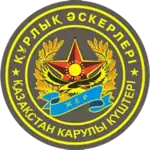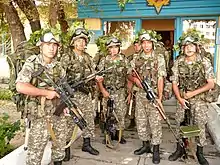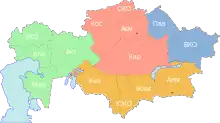Kazakh Ground Forces
The Kazakh Ground Forces (Kazakh: Қазақстан Республикасы Қарулы Күштерінің Құрлық, Qazaqstan Respýblıkasy Qarýly Kúshteriniń Qurlyq; Russian: Сухопутных войск Республики Казахстан) is the land service branch of the Armed Forces of the Republic of Kazakhstan. It is one of the three uniformed military services, and is the most senior branch of the Kazakh military in order of precedence. The main tasks of the Ground Forces include the following:[1] maintaining the readiness of troops to repel aggression, the armed defense of the territorial integrity and sovereignty of Kazakhstan, protecting the state and military facilities, peacekeeping missions. In its duties, it primarily engages in land warfare and combined arms operations, including armored and mechanized operations as well as airborne and air assault operations. It is headed by a chief military officer, the Commander of the Ground Forces who is also a member of the General Staff.
| Kazakh Ground Forces | |
|---|---|
| Қазақстан Республикасы Қарулы Күштерінің Құрлық Qazaqstan Respýblıkasy Qarýly Kúshteriniń Qurlyq Сухопутных войск Республики Казахстан | |
 Shoulder Patch of the Kazakh Ground Forces | |
| Founded | 9 April 1993 |
| Country | |
| Branch | |
| Type | Ground Force |
| Size | 20,000 |
| Part of | |
| Directorate of the Commander-in-Chief | 44 Victory Avenue, Nur-Sultan |
| Anniversaries | 7 May |
| Engagements | Tajikistani Civil War Iraq War |
| Commanders | |
| Supreme Commander-in-chief | Kassym-Jomart Tokayev |
| Chief of the General Staff | Major General Murat Bektanov |
| Commander of the Ground Forces | Major General Talgat Koibakov |
History
Soviet era
Many large units of the Turkestan Military District was redeployed from the Turkmen SSR to Eastern Kazakhstan back in the 1960s. Immediately prior to its dissolution, the 40th Army consisted of the 78th Tank Division, the 5202nd Base for Storage of Weapons and Equipment (prior to 1989, the 71st Motor Rifle Division), the 5203rd Storage Base in Ust-Kamenogorsk (prior to 1989, the 155th Motor Rifle Division), the 5204th Storage Bade at Karaganda (prior to 1989, the 203rd Zaporozhye Khingan Motor Rifle Division), the 69th Tank Division and the 10th Fortified Area.[2] The 69th Tank Division and the 10th Fortified Area were both disbanded in 1992.
Post-independence
The Kazakh Army was founded on 9 April 1993, by the order of Defense Minister Sagadat Nurmagambetov. It followed the enacting of the law, "On Defense and Armed Forces of the Republic of Kazakhstan", which is the legal basis for the Kazakh military structures.[3] The former Soviet structure of troops was preserved, with the Kazakh Army being made up of the Soviet 32nd Army, which had been serving in the Kazakh Soviet Socialist Republic for many years before it came under Kazakh government control in May 1992.[4] That month, on the basis of the 5203rd Military Equipment Storage Base (formerly the 155th Motorized Rifle Division), the 511th Motorized Rifle Regiment was re-formed with a deployment in the settlement. Georgievka, Semipalatinsk Region.
In the middle of the 1990s, the Kazakh Ground Forces included the 1st Army Corps (HQ Semipalatinsk), the 68th Motor Rifle Division (Sary-Ozek in the Kyzylorda Province), 2 motor-rifle and one tank regiments and the 78th Tank Division (HQ Ayaguz).[5] While the 68th Division was called a motor-rifle formation, in equipment terms it had almost 300 tanks and about 500 armoured fighting vehicles. The 78th Tank Division had 350 tanks, 290 armoured fighting vehicles and 150 artillery pieces. The 210th Guards Training Center (often called the Division of Guards by Kazakh sources), had 6,000 soldiers and officers and 220 tanks and 220 artillery pieces, so was a strengthened division. In 1997, the 2nd Army Corps was created with headquarters in Almaty, under which all units and formations in the Almaty, Zhambyl and South Kazakhstan regions were transferred.
On 17 November 1997, the General Purpose Forces were formed.[6] In 2000, on the basis of the 35th Guards Airborne Assault Brigade, the Mobile Forces of the Armed Forces were created, which in 2003 were renamed into Airmobile Forces as part of the Ground Forces. In 2015, Airmobile Troops were renamed Air Assault Troops.[7][8] Since 2002, the ground forces have begun the transition to a brigade structure. In this regard, there was a process of disbandment of divisions and the creation of brigades on the basis of regiments.[9]
Regular army
Regional Commands
On July 6, 2000, military districts (Kazakh: әскери округтер) were created to control the ground forces:[10]
- Central Military District (HQ Karaganda)
- Eastern Military District (HQ Semey)
- Western Military District (HQ Atyrau)
- Southern Military District (HQ Taraz)
The Eastern Military District was formed on the basis of the administration of the 1st Army Corps.[11] The Directorate of the Southern Military District (Military Unit 03858) was created in Taraz on 15 September 2000, on the basis of the directorate of the 2nd Army Corps and the Directorate of the Ground Forces.[12][13] On 7 May 2003, the military districts were renamed into regional commands (Kazakh: өңірлік қолбасшылықтар)[14][15] Currently, the ground forces include four regional commands:[16]
- Regional Command "Astana" (HQ Karaganda)
- Regional Command "East" (HQ Semey)
- Regional Command "West" (HQ Atyrau)
- Regional Command "South" (HQ Taraz)
Each of the commands have the following general composition:[17]
- One mechanized division (comprising three tank regiments and one artillery regiment)
- One motor rifle division (comprising one tank brigade, two motor rifle regiments, and one artillery regiment)
- One training center with two motor rifle regiments
- One motor rifle training regiment
- One tank training regiment
- One artillery regiment
- Three independent motor rifle brigades
- Two artillery brigades
- One engineer brigade
Regional Command "Astana"
It is located within the administrative boundaries of Akmola, Karagandy Province, Kostanay Province and North Kazakhstan. The command acts as the Supreme Commander's reserve. The District includes the following units:[18]
- 7th Separate Motor Rifle Brigade at Karaganda
- Reconnaissance Regiment at Aktas
- 401st Cannon Artillery Brigade at Ungurtas
- 402nd Rocket Artillery Brigade at Priozersk
- 403rd Anti-tank Artillery Brigade at Priozersk
- Training Center for Combat Training of Junior Specialists and the Reserve at Spassk
- Missile Forces and Artillery Training Center at Priozersk
The command has had the following commanders:
- Major General Vladimir Shatsky (April 2008–?)[18]
- Colonel Mereke Kuchekbaev (since 9 January 2020)[19]
Regional Command "East"
It is located within the administrative boundaries of East Kazakhstan and Pavlodar Province (Families, Ust-Kamenogorsk, George, and Ayagoz Usharalsky Garrisons). The District has the following units:[18]
- 3rd Mechanized Brigade (formerly the 78th Tank Division) at Ayaguz
- 3rd Separate Motor Rifle Brigade at Usharal (Military Unit No.40398, formed on the basis of a motor rifle regiment of the 155th Motor Rifle Division)
- 4th Mechanized Brigade at Novo-Akhmirovo, Ust-Kamenogorsk (Military Unit No.27943)
- 8th Mechanized Brigade at Semey[20][21]
- 11th Tank Brigade at Ayagoz
- 34th Artillery Brigade at Usharal
- 101st Missile Brigade at Semey
- 102nd Rocket Artillery Brigade at Semey
- 103rd Cannon Artillery Brigade at Semey
- Separate Reconnaissance Regiment at Semey
- Separate Communications Brigade at Semey
- Artillery Brigade
- Air Defence Missile Brigade
- Three Storage Bases
The command has had the following commanders:[18]
- Lieutenant General Nikolai Pospelov (September 2008–?)
- Major General Asan Zhusupov (since September 2019)[22]
Regional Command "West"
It is located within the administrative boundaries of the West Kazakhstan Province, Aktobe Province, Atyrau Province and Mangystau Province. The main task is ensuring the integrity of state borders, territorial integrity, sovereignty and economic interests of Kazakhstan in the Kazakh sector of the Caspian Sea. The District has the following units:[18]
- 100th Artillery Brigade at Aktobe
- Separate Motorized Rifle Battalion at Aktobe
- 390th Guards Naval Infantry Brigade at Aktau
- Separate Reconnaissance Regiment at Atyrau
- Separate Motorized Rifle Battalion at Beineu
- Separate Motor Rifle Brigade
- Artillery Brigade
The command has had the following commanders:[18]
- General Alimzhan Erniyazov (2008–?)
Regional Command "South"
It is located within the administrative boundaries of Almaty Province, Zhambyl Province, South Kazakhstan Province and Kyzylorda Province. The district's main task is ensuring security in the south-eastern borders of the country. The District includes the following:[18]
- 5th Mountain Rifle Brigade at Taraz
- Separate Motor Rifle Battalion at Lugovoi
- Separate Tank Battalion at Lugovoi
- Separate Reconnaissance Battalion at Lugovoi
- Separate Motor Rifle Battalion at Merke
- 6th Mechanized Brigade at Shymkent
- Separate Mountain-Jaeger Regiment
- Otar Military Base
- 12th Mechanized Brigade[23][24][25]
- 54th Guards Artillery Brigade
- 23rd Engineer Brigade
- Training Center of the Ground Forces named after Karasai Batyr
- 221st Separate Communications Brigade at Taraz
- 232nd Engineer Brigade at Kapchagai
The command has had the following commanders:[18]
- General Uali Elamanov (2003—2004)
- General Bakhtiyar Syzdykov (2004—2007)
- General Bulat Darbekov (2007—2008)
- General Alikhan Dzharbulov (2008–?)
- Major General Talgat Koibakov (2012–2016)
- Major General Marat Khusainov (2016–2019)
- Major General Kaidar Karakulov (since 2019)
Airmobile forces

The Airmobile Forces were formed by grouping the 35th Guards Air Assault Brigade (which arrived from Germany in April 1991, and was taken over by Kazakhstan in 1992) with new brigades formed from previous Soviet units. In October 2003, the 36th Separate Air Assault Brigade was formed on the basis of the 2nd Motor Rifle Brigade. On the basis of Taldykorgan Motor Rifle Regiment, in April 2003 the 37th Separate Air Assault Brigade was formed. The 38th Air Assault Brigade is also known as the KAZBRIG Peacekeeping Brigade and was given its current name in 2007.[26]
The Airmobile Forces consists of the following units:
- 35th Guards Air Assault Brigade (Kapshagai)
- 36th Air Assault Brigade (Nur-Sultan)
- 37th Air Assault Brigade (Taldykorgan)
- 38th Air Assault Brigade[27][28][29]
Artillery and Missile Forces
The Artillery and Missile Forces of Kazakhstan was formed in 1992 on the basis of the headquarters of the Missile Forces and Artillery of the Central Asian Military District of the Soviet Armed Forces. At first, they were structurally part of the Special Forces of the Ministry of Defense, and then the General Purpose Forces. Since 2003, they have operated as a separate branch of the military under the Ground Forces. Units and subunits are equipped with all the necessary types of missile and artillery systems of caliber from 82 to 300 mm.
The Department of Artillery has been operating at the Military Institute of the Ground Forces since 1993, which annually graduates up to 60 officers-artillerymen. In 2014, on the basis of the National University of Defense, the Department of Missile Forces and Artillery was created. Professional officers of this profile are also trained at the Mikhailovskaya Military Artillery Academy in St. Petersburg. Additionally, the forces are replenished by graduates of the military departments of the Karaganda State Technical University and the Almaty Satbayev University. In 1998, at the Matybulak training ground, three Tochka-U tactical missiles were launched, the launch of the first rocket from which was then carried out by President Nazarbayev. In 2002, at the Saryshagan training ground, operational-tactical exercises of the Rocket Forces and Artillery “Shield of the Motherland” were held.[31]
The current commander is Colonel Askar Zholamanov.[32] 19 November is celebrated as the Day of Missile Forces and Artillery.[33]

Training
Military Institute

The Military Institute of the Kazakh Ground Forces (Kazakh: Qurlyq áskerleriniń áskerı ınstıtýty / Құрлық әскерлерінің әскери институты) is the main educational institute of the Ground Forces, and one of the leading Kazakh military academies. It has many notable alumni, including Lieutenant General Murat Maikeyev, Colonel General Saken Zhasuzakov and Major General Abibilla Kudayberdiev.[34]
Junior Specialist Training
The training of junior specialists of rank and file in military accounting specialties for the Ground Forces is carried out in the following training centers:
- Training Center for Junior Specialists of the Kazakh Ground Forces named for Karasai Batyr – Jambyl Region[35]
- Training Center for Combat Training of Junior Specialists and the Reserve of the Ground Forces – Spassk, Karaganda[36]
- Training Center of the Missile Forces and Artillery – Priozersk, Karaganda
Cadet Corps
The Cadet Corps named after Shoqan Walikhanov is an institution of the ministry of defense was formed on 1 July 1996 as a secondary school that prepared Kazakh youth for service in the military. A month after its formation, the corps had 96 enlisted cadets, most of whom came from the Alma-Ata Higher All-Arms Command School. On its first graduation day in 1999, the corps received its own battle flag by the then head of the corps, Colonel Kuangaliev and defense minister Mukhtar Altynbayev. The corps is currently based in the city of Shchuchinsk in the Akmola Region.[37][38]
Foreign education
Some of Kazakhstan's officers have trained at the United States Military Academy at West Point.
Equipment
.jpg.webp)
| Name | Origin | Type | In service | ||
|---|---|---|---|---|---|
| Armored fighting vehicle | |||||
| T-80 Shigiz
T-72 Shigiz T-64 Kz T-62 Kz T-55 Kz |
Main battle tank | 100
1800 460 280 540 | |||
| Barys 8x8
Barys 6x6 BTR 82A BTR 80A BTR 70 BTR 60 MTLB |
Armoured personnel carrier | 600
200 180 300 350 150 686 | |||
| BMP-1
BMP 1K |
Infantry fighting vehicle | 730
800 140 260[39] | |||
| Humvee
COBRA ARLAN |
Infantry mobility vehicle | 90
80 130 40 600[39] | |||
| D 20
D 30 2A36 2A65 M46 MT12 |
howitzer | 80
450 180 190 350 125 | |||
| 2S1 Gvozdika
Semser Aybat |
self-propelled howitzer | 120
120 19 68 180 18 | |||
| BM-21 Grad
Lynx TOS A1 Nayza |
multiple rocket launcher | 200
180 35 18 6 380 | |||
References
- https://www.globalsecurity.org/military/world/centralasia/kazak-army.htm
- Michael Holm, 32nd Combined Arms Army, 2015.
- "Shield of the State · Publications · "Kazakhstan History" portal". e-history.kz.
- ir.kz. "Сухопутные войска". www.mod.gov.kz.
- Machine translated and cleaned up from a Russian source at http://www.nomad.su/?a=2-200205081022, 'Military-political safety of Kazakhstan'
- "Указ от 17 ноября 1997 года № 3761 «О дальнейших мерах по реформированию Вооруженных Сил Республики Казахстан»". www.adilet.zan.kz. Retrieved 2019-01-14.
- "История создания Аэромобильных войск Республики Казахстан. — Десантура.ру – о десанте без границ". Archived from the original on 2013-01-20. Retrieved 2013-01-11.
- Александр Мироглов. "Возвращение в десантуру". www.np.kz. Retrieved 2019-01-14.
- "Кто такой морской пехотинец в Казахстане?". www.sarbaz.kz. Retrieved 2019-01-14.
- "Указ Президента от 06.07.2000 N 417 «О структуре Вооружённых сил Республики Казахстан» (ред. от 07.05.2003)". www.kazakhstan.news-city.info. Archived from the original on 2017-10-09. Retrieved 2019-01-14.
- "РгК "Восток" – четверть века боевой готовности". www.sarbaz.kz. Archived from the original on 2019-01-15. Retrieved 2019-01-14.
- Раимжан Салиходжаев. "Как создавалось Региональное командование «Юг»". www.sarbaz.kz. Archived from the original on 2017-06-02. Retrieved 2019-01-15.
- INFORM.KZ (2020-09-26). "«По-боевому» отметило свой юбилей региональное командование «Юг»". www.inform.kz (in Russian). Retrieved 2021-01-09.
- "Указ Президента Республики Казахстан от 7 мая 2003 года № 1085 «О мерах по дальнейшему совершенствованию структуры Вооруженных Сил Республики Казахстан»". www.online.zakon.kz. Retrieved 2019-01-15.
- "Вооруженные силы РК – Структура – Министерство обороны Республики Казахстан (МО РК)". www.mod.gov.kz.
- Most specific unit information, including military unit numbers, locations, etc. is sourced from Vad777, "kazachstan-grand". www8.brinkster.com (in Esperanto). 2012-03-24. Archived from the original on 2012-03-24. Retrieved 2020-09-03.
- https://www.globalsecurity.org/military/world/centralasia/kazak-regional.htm
- Most specific unit information, including military unit numbers, locations, etc. is sourced from Vad777, Kazakh Ground Forces Archived March 24, 2012, at the Wayback Machine, accessed February 2010
- "Назначен командующий войсками РК "Астана"". tengrinews.kz. 09.01.2020. Check date values in:
|date=(help) - Порядковый номер бригады в открытых источниках не приводится
- "Войсковая часть 30217 РгК «Восток» отметила 27-ую годовщину со дня образования". Archived from the original on 2017-02-02. Retrieved 2017-01-23.
- "ЖУСУПОВ Асан Куанышевич | ЦентрАзия". centrasia.org. Retrieved 2021-01-09.
- -divizii.html One more soldier in Otar Tank Brigade was convicted Archived 2016-10-13 at the Wayback Machine
- proshu.html Major General Talgat Koibakov: I ask the mothers and girls of the recruits not to bother them again
- The Minister of Defense of the Republic of Kazakhstan inspected the Guards and Saryozeks garrisons
- unipath-magazine.com https://unipath-magazine.com/kazakhstan-pursues-peacekeeping/. Retrieved 2021-01-09. Missing or empty
|title=(help) - Most specific unit information, including military unit numbers, locations, etc. is sourced from Vad777, Kazakh Ground Forces Archived March 24, 2012, at the Wayback Machine, accessed February 2010
- Archived March 31, 2012, at the Wayback Machine
- "Kazakhstan and International Peacekeeping: Experience and Potential". Retrieved 2021-01-09.
- "Аскар Жоламанов: Испытываю гордость за нашу армию и ответственность". rus.azattyq-ruhy.kz (in Russian). 2020-11-16. Retrieved 2021-01-09.
- "Жоламанов Аскар Ахметович (персональная справка)". Информационная система ПАРАГРАФ. Retrieved 2021-01-09.
- INFORM.KZ (2019-11-19). "19 ноября – День Ракетных войск и артиллерии". www.inform.kz (in Russian). Retrieved 2021-01-09.
- "Министр обороны Кыргызской Республики Кудайбердиев Абибилла Алымович". mil.kg (in Russian). 2014-07-24. Archived from the original on 2014-07-24. Retrieved 2020-09-03.
- "Легендарная стрелковая дивизия отметила 75-летний юбилей". www.sarbaz.kz. Archived from the original on 2019-01-16. Retrieved 2019-01-16.
- "В Спасске Карагандинской области открыт учебный центр боевой подготовки младших специалистов и резерва Вооруженных сил РК". www.inform.kz. Retrieved 2019-01-16.
- https://e-history.kz/en/publications/view/3087
- https://www.mod.gov.kz/rus/obrazovanie/srednee_obrazovanie/uch_zavedeniya/?cid=0&rid=383
- "Trade Registers". armstrade.sipri.org. Retrieved 2020-09-03.